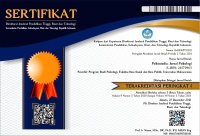DIR/floortime Approach to Improve Two-way Communication Skills in Children with Autism Spectrum Disorder
Abstract
The limited ability to engage in two-way social communication poses a significant challenge for children with Autism Spectrum Disorder (ASD). Nevertheless, proficiency in two-way social communication is a crucial skill that children need to foster for their overall development. This study employs a single-subject design (n=1), focusing on early childhood and involving fathers as the primary caregivers. The primary objective is to assess the effectiveness of the DIR/Floortime approach, specifically in enhancing communication skills in children with autism spectrum disorders. This study consisted of 16 sessions which divided into pre-intervention, intervention, and post-intervention sessions. Measurement was conducted using the Circle of Communication (CoC) observation sheet and the Functional-Emotional Assessment Scale (FEAS) to compare participant change in score trends between pre-intervention and post-intervention phases. The research findings indicate that the application of DIR/Floortime principles effective in improving the two-way communication abilities of children with autism spectrum disorders. Consequently, this approach can be considered as an alternative consideration for the intervention of children with autism spectrum disorders.
Minimnya kemampuan untuk melakukan komunikasi sosial dua arah menjadi salah satu masalah utama pada anak dengan Autism Spectrum Disorder (ASD) atau Gangguan Spektrum Autisme. Padahal, kemampuan komunikasi sosial dua arah merupakan salah satu kemampuan penting yang perlu dimiliki oleh anak agar dapat menunjang perkembangannya. Penelitian ini merupakan penelitian single subject design (n = 1) pada anak usia dini dan ayah sebagai pengasuh utama anak yang bertujuan untuk mengetahui efektivitas dari pendekatan DIR/Floortime khususnya dalam meningkatkan kemampuan komunikasi pada anak dengan gangguan spektrum autisme. Penelitian terdiri dari 16 sesi yang terbagi menjadi sesi pra-intervensi, intervensi, dan sesi post-intervensi. Pengukuran menggunakan lembar observasi Circle of Communication (CoC) dan Functional-Emotional Assessment Scale (FEAS) untuk membandingkan perubahan tren skor partisipan pada pra-intervensi dan post-intervensi. Hasil penelitian menunjukkan bahwa penerapan prinsip-prinsip DIR/floortime dapat meningkatkan kemampuan komunikasi dua arah anak dengan gangguan spektrum autisme. Oleh karena itu, pendekatan ini dapat dijadikan salah satu pertimbangan alternatif penanganan anak dengan gangguan spektrum autisme.
Keywords
Full Text:
FULL TEXTReferences
American Psychiatric Association. (2022). Neurodevelopmental disorders. In Diagnostic and statistical manual of mental disorders (5th ed., text rev.) (pp. 56–67). American Psychiatric Association Press.
Andrea Lee Davis, Lahela Isaacson, & Michelle Harwell. (2018). Floortime strategies to promote development in children and teens: A user’s guide to the DIR model. . Brookes Publishing.
Barghi, F., Safarzadeh, S., Marashian, F. S., & Bakhtiarpour, S. (2023). Effectiveness of DIR/Floor Time Play Therapy in Social Skills and Emotion Regulation of Children with Autism Spectrum Disorder. Middle East Journal of Rehabilitation and Health Studies, 11(2). https://doi.org/10.5812/mejrh-138491
Boshoff, K., Bowen, H., Paton, H., Cameron-Smith, S., Graetz, S., Young, A., & Lane, K. (2020). Child Development Outcomes of DIR/Floortime TM-based Programs: A Systematic Review. Canadian Journal of Occupational Therapy, 87(2), 153–164. https://doi.org/10.1177/0008417419899224
Bradshaw, J., Koegel, L. K., & Koegel, R. L. (2017). Improving Functional Language and Social Motivation with a Parent-Mediated Intervention for Toddlers with Autism Spectrum Disorder. Journal of Autism and Developmental Disorders, 47(8), 2443–2458. https://doi.org/10.1007/s10803-017-3155-8
Deb, S., Retzer, A., Roy, M., Acharya, R., Limbu, B., & Roy, A. (2020). The effectiveness of parent training for children with autism spectrum disorder: a systematic review and meta-analyses. BMC Psychiatry, 20(1), 583. https://doi.org/10.1186/s12888-020-02973-7
Divya, K. Y., Begum, F., John, S. E., & Francis, F. (2023). DIR/floor time in engaging autism: a systematic review. Iranian Journal of Nursing and Midwifery Research, 28(2), 132–138.
Firnady, D. A., & Boediman, L. M. (2019). Floortime Approach to Increase Communication Skills for Children With Autism Spectrum Disorder and Intellectual Impairment. 3rd International Conference on Intervention and Applied Psychology (ICIAP 2019) and the 4th Universitas Indonesia Psychology Symposium for Undergraduate Research (UIPSUR 2019), 81–93.
Gravetter, F., & Forzano, L.-A. B. (2018). Research Methods for the Behavioral Sciences (6th ed.). Cengage Learning.
Greenspan, S. I., & Wieder, S. (2000a). Developmentally appropriate interactions and practice. In ICDL Clinical practice guidelines: Redefining the standards of care for infants, children, and families with special needs (pp. 261–282).
Greenspan, S. I., & Wieder, S. (2000b). Principles of clinical practice for assessment and intervention. In Clinical practice guideline: Redefining the standards of care for infants, children, and families with special needs (pp. 55–82). Interdisciplinary Council on Developmental and Learning Disorders.
Greenspan, S. I., & Wieder, S. (2009). Engaging autism: Using the floortime approach to help children relate, communicate, and think. Da Capo Press.
Hampton, L. H., & Kaiser, A. P. (2016). Intervention effects on spoken‐language outcomes for children with autism: a systematic review and meta‐analysis. Journal of Intellectual Disability Research, 60(5), 444–463. https://doi.org/10.1111/jir.12283
Isnannisa, E. D. (2019). DIR/floortime untuk meningkatkan komunikasi antara anak dengan autism dan ibu dengan profil sensori berbeda. Universitas Indonesia.
Kasari, C., Gulsrud, A. C., Wong, C., Kwon, S., & Locke, J. (2010). Randomized controlled caregiver mediated joint engagement intervention for toddlers with autism. Journal of Autism and Developmental Disorders, 40, 1045–1056.
Lal, R., & Chhabri, R. (2013). Early Intervention of Autism: A Case for Floor Time Approach. In Recent Advances in Autism Spectrum Disorders - Volume I. InTech. https://doi.org/10.5772/54378
Lalitya, L. (2019). Penerapan pendekatan DIR/floortime untuk meningkatkan komunikasi dua arah pada anak usia dini dengan keterlambatan perkembangan. Universitas Indonesia.
Liao, S.-T., Hwang, Y.-S., Chen, Y.-J., Lee, P., Chen, S.-J., & Lin, L.-Y. (2014). Home-based DIR/FloortimeTM Intervention Program for Preschool Children with Autism Spectrum Disorders: Preliminary Findings. Physical & Occupational Therapy In Pediatrics, 34(4), 356–367. https://doi.org/10.3109/01942638.2014.918074
Novianti, A., Ayuningtyas, A. L., & Kurniawati, F. (2022). Intervensi orang tua pada anak dengan autism spectrum disorder. Jurnal Obsesi: Jurnal Pendidikan Anak Usia Dini, 6, 918–934.
Pacheco, P., Pacheco, M., & Molini-Avejonas, D. (2021). Study of 18 months of follow up dir floortime intervention in preschool children with autism spectrum disorder (ASD). European Psychiatry, 64(S1), S503–S503. https://doi.org/10.1192/j.eurpsy.2021.1346
Pajareya, K., & Nopmaneejumruslers, K. (2012). A one-year prospective follow-up study of a DIR/FloortimeTM parent training intervention for preschool children with autistic spectrum disorders. Journal of the Medical Association of Thailand, 95(9), 1184.
Praphatthanakunwong, N., Kiatrungrit, K., Hongsanguansri, S., & Nopmaneejumruslers, K. (2018). Factors associated with parent engagement in DIR/Floortime for treatment of children with autism spectrum disorder. General Psychiatry, 31(2), e000009. https://doi.org/10.1136/gpsych-2018-000009
Purnomo, S. (2023). Application of developmental, individual differences, relation-based (DIR / Floortime) in children with developmental disorders of the neurological system and brain. Psikostudia: Jurnal Psikologi, 12(1), 294.
Rojas-Torres, L. P., Alonso-Esteban, Y., & Alcantud-Marín, F. (2020). Early Intervention with Parents of Children with Autism Spectrum Disorders: A Review of Programs. Children, 7(12), 294. https://doi.org/10.3390/children7120294
Shamsudin, I. D., Brown, T., Yu, M.-L., & Lentin, P. (2021). Parents of children with autism spectrum disorder’s perception on parent-implemented home-based developmental, individual-difference and relationship (DIR)/Floortime ® intervention. Advances in Autism, 7(4), 294–310. https://doi.org/10.1108/AIA-05-2020-0032
Solomon, R., Necheles, J., Ferch, C., & Bruckman, D. (2007). Pilot study of a parent training program for young children with autism. Autism, 11(3), 205–224. https://doi.org/10.1177/1362361307076842
Watkins, L., Kuhn, M., Ledbetter-Cho, K., Gevarter, C., & O’Reilly, M. (2017). Evidence-Based Social Communication Interventions for Children with Autism Spectrum Disorder. The Indian Journal of Pediatrics, 84(1), 68–75. https://doi.org/10.1007/s12098-015-1938-5
Zwaigenbaum, L., Bauman, M. L., Choueiri, R., Kasari, C., Carter, A., Granpeesheh, D., Mailloux, Z., Smith Roley, S., Wagner, S., Fein, D., Pierce, K., Buie, T., Davis, P. A., Newschaffer, C., Robins, D., Wetherby, A., Stone, W. L., Yirmiya, N., Estes, A., … Natowicz, M. R. (2015). Early Intervention for Children With Autism Spectrum Disorder Under 3 Years of Age: Recommendations for Practice and Research. Pediatrics, 136(Supplement_1), S60–S81. https://doi.org/10.1542/peds.2014-3667E
DOI: http://dx.doi.org/10.30872/psikostudia.v13i2.14419
Refbacks
- There are currently no refbacks.
Copyright (c) 2024 Hana Lazuardy Rahmani & Lia Mawarsari Boediman

This work is licensed under a Creative Commons Attribution-ShareAlike 4.0 International License.
Psikostudia: Jurnal Psikologi is indexed by :
PSIKOSTUDIA: Jurnal Psikologi Published by Faculty of Social and Political Siences, University of Mulawarman, Samarinda, East Kalimantan and This work is licensed under a Creative Commons Attribution-ShareAlike 4.0 International License.
_________________________________________
PSIKOSTUDIA: Jurnal Psikologi
Department of Psychology
Faculty of Social and Political Siences, University of Mulawarman
Jl. Muara Muntai Kampus Gn. Kelua Samarinda 75411
Phone: +62 813 35350368
E-Mail: psikostudia@fisip.unmul.ac.id




















